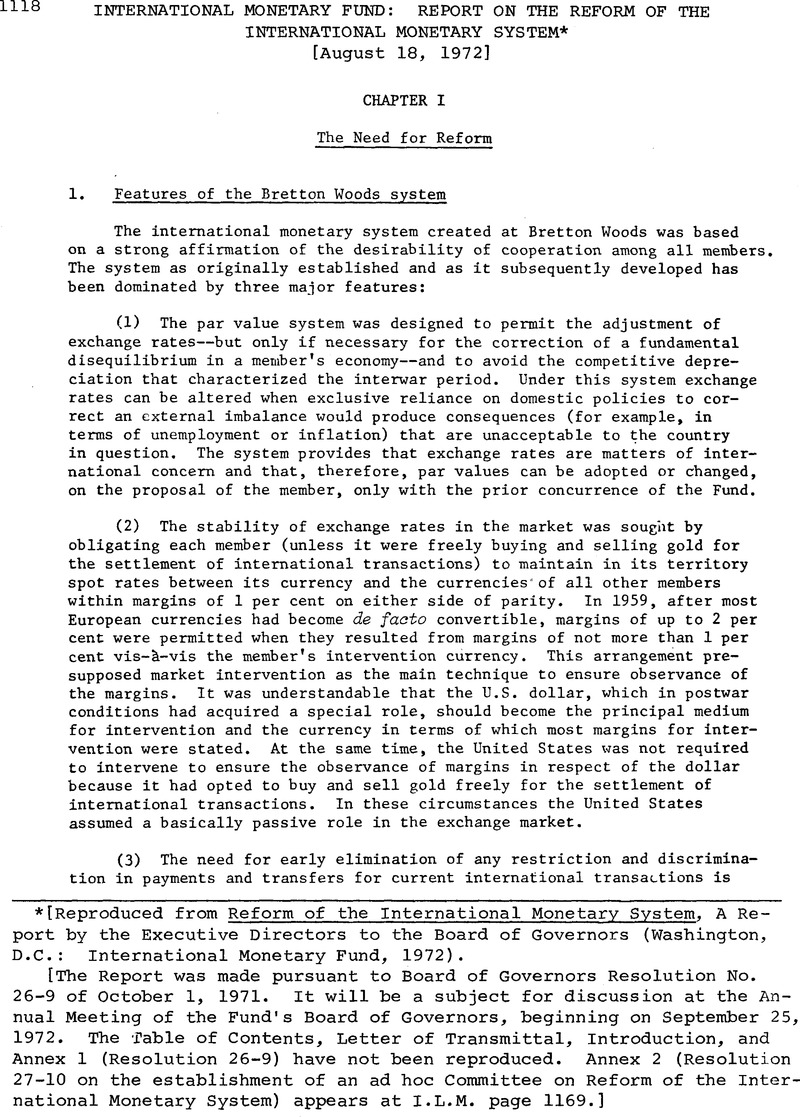No CrossRef data available.
Published online by Cambridge University Press: 04 April 2017

[Reproduced from Reform of the International Monetary System, A Report by the Executive Directors to the Board of Governors (Washington, D.C.: International Monetary Fund, 1972).
[The Report was made pursuant to Board of Governors Resolution No. 26-9 of October 1, 1971. It will be a subject for discussion at the Annual Meeting of the Fund’s Board of Governors, beginning on September 25, 1972. The Table of Contents, Letter of Transmittal, Introduction, and Annex 1 (Resolution 26-9) have not been reproduced. Annex 2 (Resolution 27-10 on the establishment of an ad hoc Committee on Reform of the Inter-national Monetary System) appears at I.L.M. page 1169.]
1 The Role of Exchange Rates in the Adjustment of International Payments: A Report by the Executive Directors, International Monetary Fund (Washington, 1970).
2 Ibid., p. 70.
1 The term “par value,” or “par,” is used in this Report to indicate the value of a currency in terms of gold or SDRs; the term “parity” denotes the relationship between two currencies, determined by the ratio of their par values.
2 Issues involved in the movement of market rates within wider margins and the appropriate width of margins are discussed in Section 5 of this chapter.
1 The relevance of the balance between devaluations and revaluations to the attractiveness of the SDR as a reserve asset is discussed in Section 3 of Chapter IV.
1 The intervention and settlement arrangements that are related to this discussion are discussed in Section 5 of Chapter III.
1 For the purpose of some of the calculations connected with Fund operations and the maintenance of the value of the Fund’s assets, the market values of currencies, in terms of gold (and of SDRs) are normally determined by taking the value of the U.S. dollar to be its par value, and that of other currencies to be calculated from their market value in U.S. dollars. If it were so desired it would be possible for these calculations to be undertaken on a different basis, with the place of the U.S. dollar taken, for example, by an appropriate combination of currencies.
1 The authority to change the official price, of gold, which is refer-red to in the Articles as the power to make uniform proportionate changes in the par values of the currencies of all members, is a reserved power of the Board of Governors and its exercise requires a majority of 85 per cent of the total voting power of members (Article IV, Section 7; Article XII, Section 2(b) (iii)).
1 Each participant is required to accept SDRs from another participant if designated by the Fund and if the acceptance of these SDRs would not increase its total holdings above 300 per cent of its net cumulative allocation.
2 Abrogation of the reconstitution obligation—which does not require amendment of the Articles and would therefore not have to await other action on reform—would remove a further reason for the maintenance of a certain volume of transactions subject to designation.